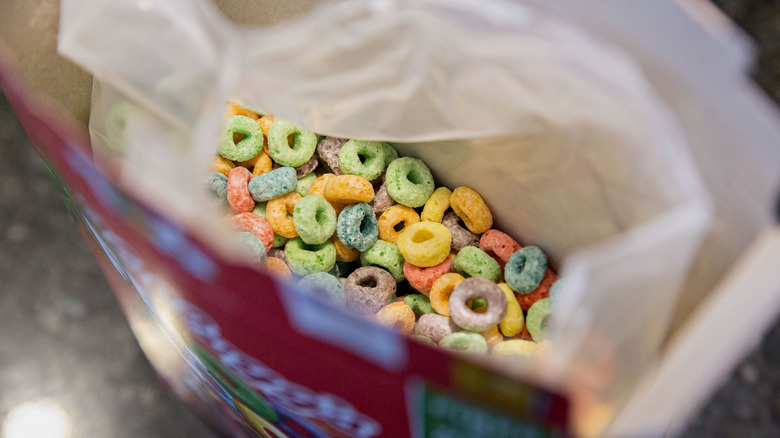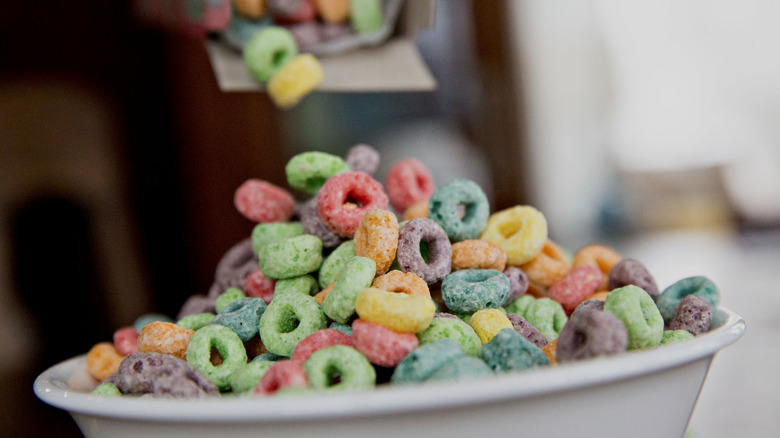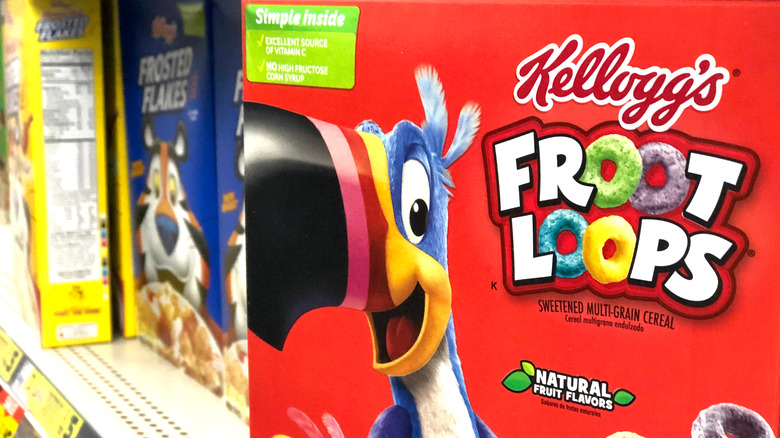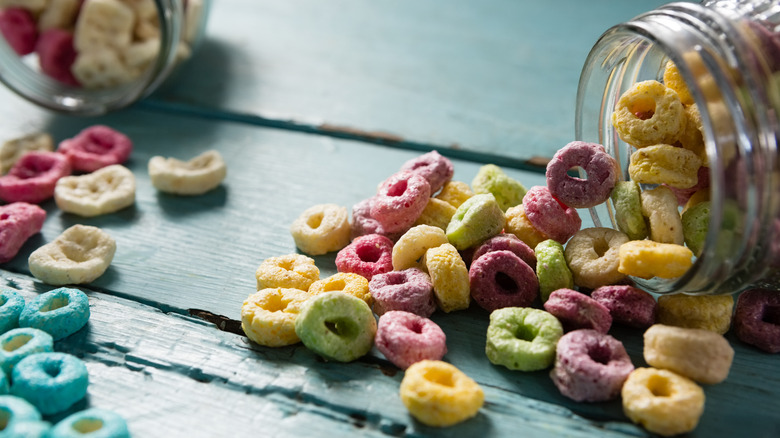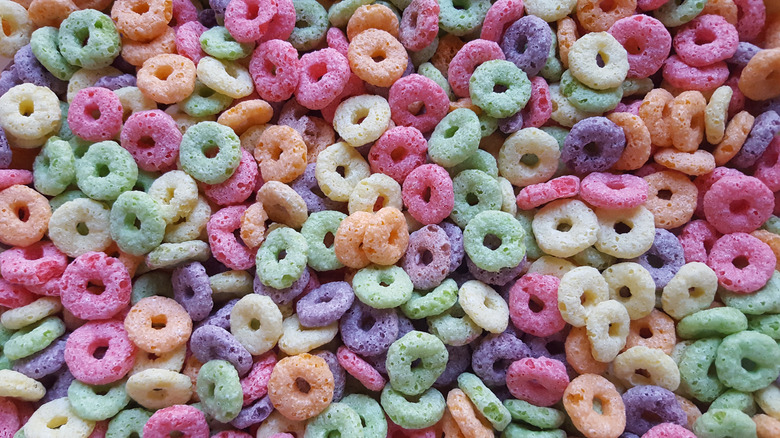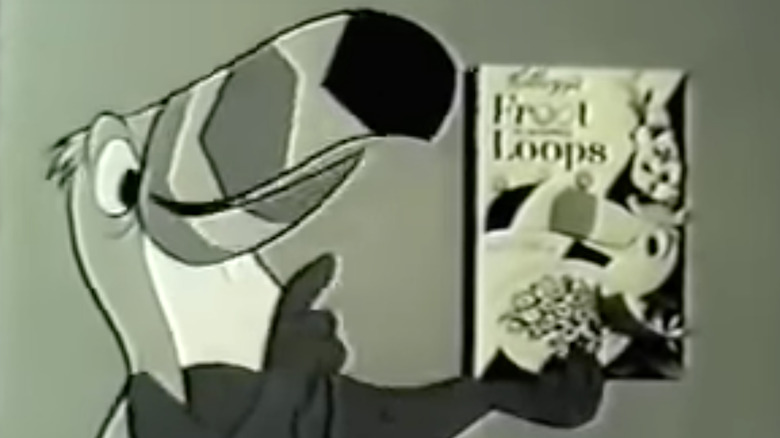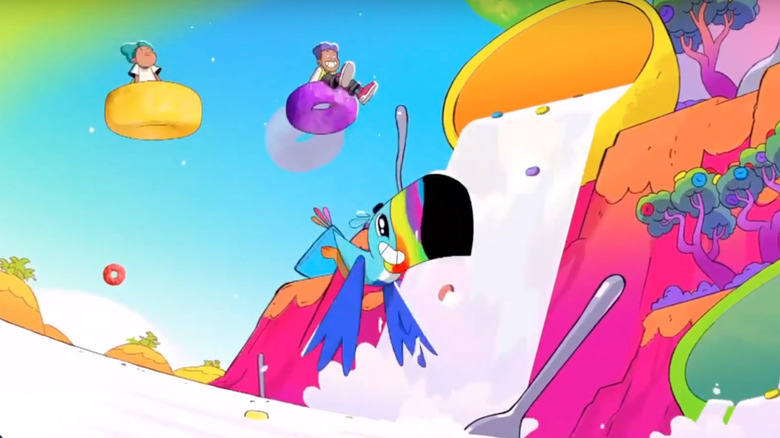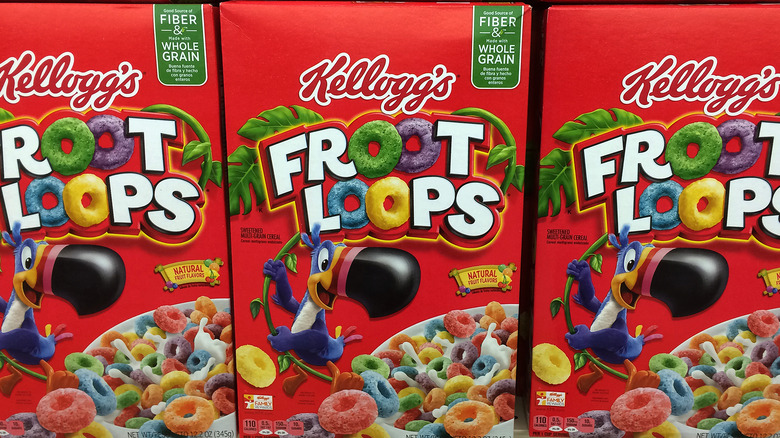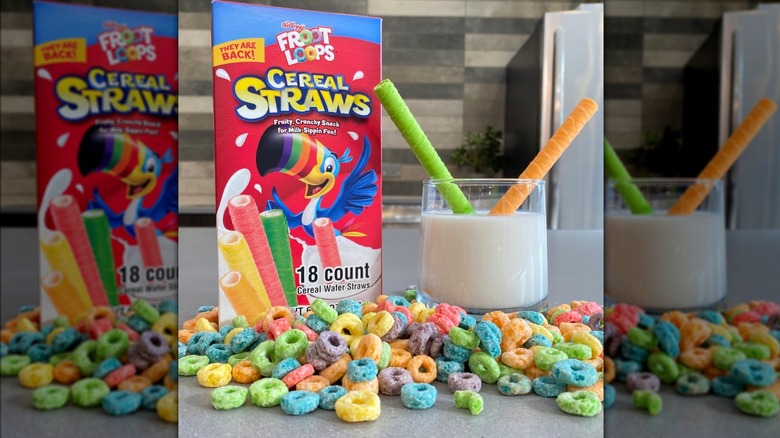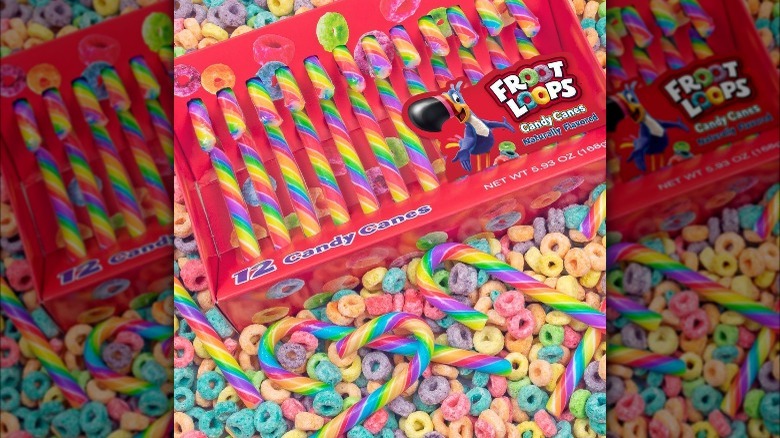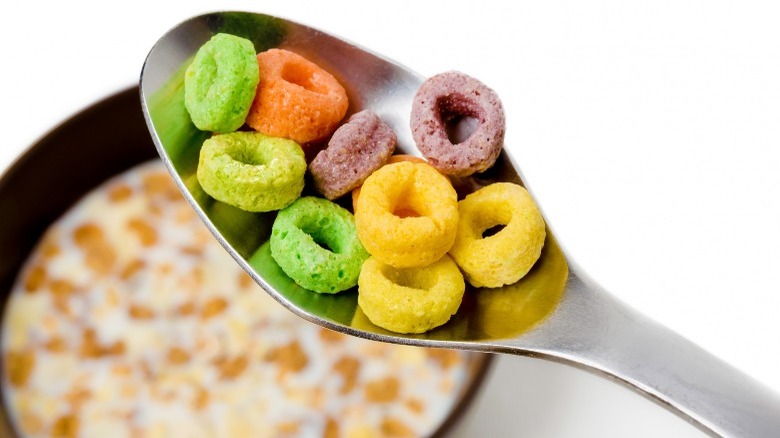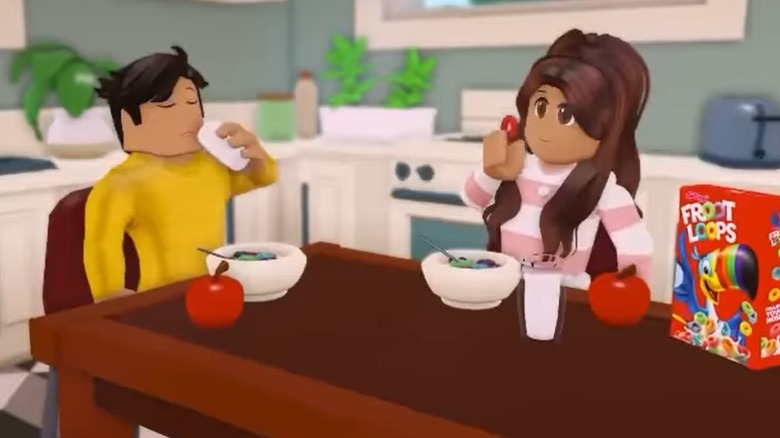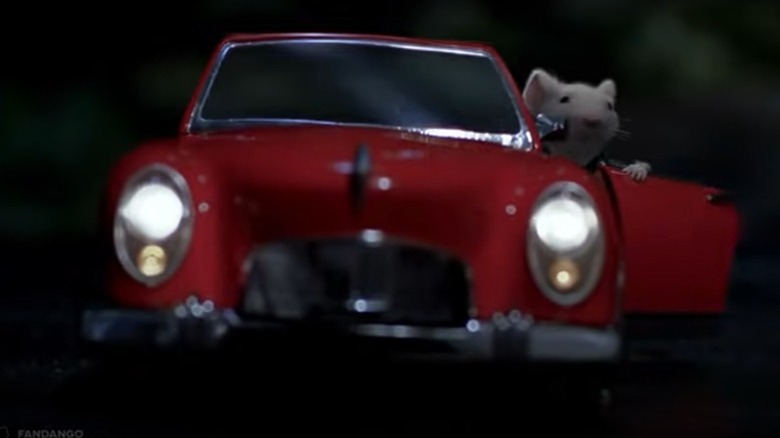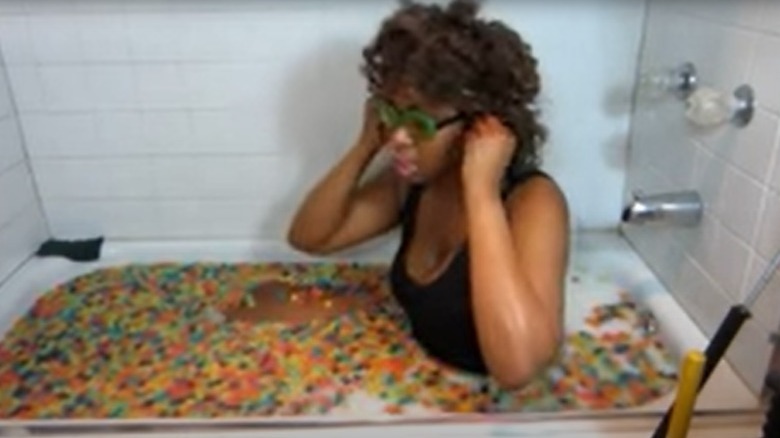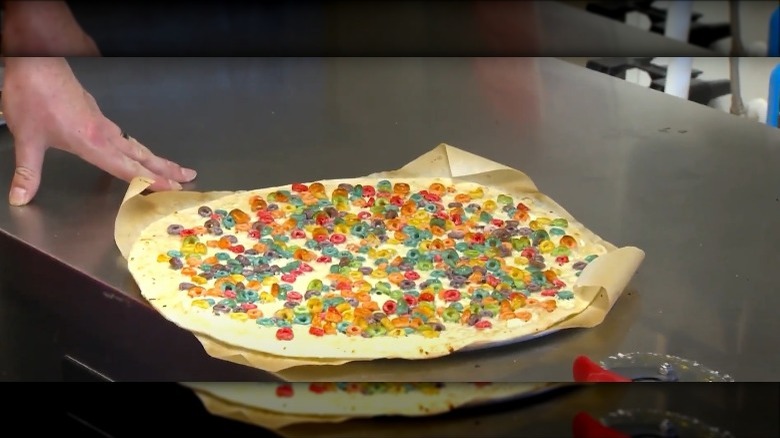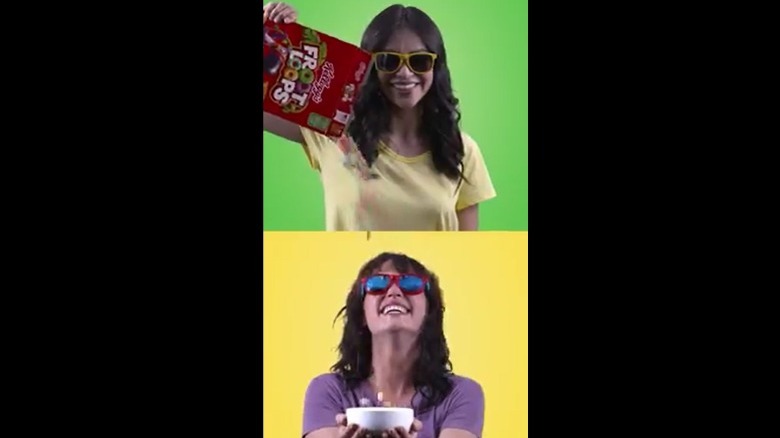The Untold Truth Of Froot Loops
Wake up and pour yourself a bowl of corn flour blend, sugar, wheat flour, whole grain oat flour, oat fiber, soluble oat fiber, a smidge of hydrogenated vegetable oil, salt, Red 40, natural flavor, Blue 2, turmeric color, Yellow 6, annatto color, Blue 1, and a helping of BHT "for freshness" for a — wait. Sorry. Pour yourself a bowl of Froot Loops for a complete breakfast.
In fairness, as Kellogg's also lists on their website, the creation of Froot Loops includes pumping it with the following added vitamins and minerals: vitamin C, niacinamide, reduced iron, zinc oxide, vitamin B6, vitamin B2, vitamin B1, vitamin A palmitate, folic acid, vitamin D, and vitamin B12.
The reason behind this blatant look at what goes into a box of Froot Loops is that such overt manufacturing (as exemplified by the ineffable category of "natural flavor") speaks to a cereal with a similarly processed and questionable history.
Froot Loops reinvented the reinvention of Cheerios
Froot Loops came into existence due to the failure of Kellogg's other cereal brand, OKs. These, as Mr Breakfast writes, were an attempt to create bootleg Cheerios (which were made by Kellogg's competitor, General Mills) with the individual pieces shaped as "O"s and "K"s. The original mascot was a highlander, but by 1962, the year the brand was discontinued, they had replaced the anonymous Scotsman with Hanna-Barbera characters like Yogi Bear.
However, Kellogg's loathed the idea that the equipment they invested in to make OKs would go to waste, so the development team set about inventing a new brand to fit the machinery. The result was Froot Loops, which as Kellogg's dates on their official timeline, came out in 1963. So, in other words, Froot Loops is the bootleg recoup of an attempt to bootleg Cheerios, differentiated primarily by the large amounts of added sugar and coloring. This history becomes even clearer when you reexamine the texture of Froot Loops, which bears an unmistakable likeness to the General Mills favorite.
Froot Loops has always been Froot Loops
According to some corners of the internet, Froot Loops was originally called Fruit Loops but had to be rebranded after an early lawsuit lobbed by Rene Paxton. The issue, however, is that the case of Paxton v. Kellogg's does not appear to exist.
The main source for this name change comes from Snack History. Snack History cites its claim with a link to a 2009 article about a contemporaneous lawsuit concerning the lack of fruit in Froot Loops shared on Over Lawyered. In the comments section of that page, a person pulls "Renee Paxton in Paxton v. Kellogg's[citation needed]" from Wikipedia. The Paxton case apparently occurred six months after Froot Loops was introduced as a substitute for OKs in 1959. However, in addition to Kellogg's claim that Froot Loops entered the world in 1963, we have archived footage of a Yogi Bear commercial for OKs that aired in 1960.
The fact that the case received no citation on Wikipedia, that there were factual inconsistencies, and that between 2009 and the writing of this article that section of the Froot Loops Wikipedia page has been removed all serve to question the existence of Paxton vs Kellogg's. Upon further searching, no primary sources or credible secondary sources document the lawsuit — not even the aforementioned 2009 lawsuit, which surely would have drawn on the name change as Kellogg's defense against any attempts to deceive the general public.
Froot Loops is an example of the Mandela Effect
The Paxton v. Kellogg's lawsuit seems to be an invention accepted by people operating under the Mandela Effect, a phenomenon in which a large group of people share a false memory, usually a detail of a largely agreed-upon event. As Good Housekeeping writes, it was named after how many people shared a memory of Nelson Mandela dying in prison decades before his actual death, though the most famous example may be the invented line "Luke, I am your father" (via YouTube).
Froot Loops vs Fruit Loops is another example of the effect, as you can see in the vast disagreement over when Froot Loops was supposed to be "Fruit Loops" in the comment sections of Alternative Memories. The conceptual disconnect may be due to how "Froot" is a stylized homonymic misspelling of "fruit," so until the moment we really pay attention to the fact that the cereal is called Froot Loops, our minds paper over the weirdness by seeing the traditional spelling of "fruit."
All Fruit Loops taste the same, but have different flavors
When Froot Loops first appeared on store shelves, Mr Breakfast notes, it came with red loops, orange loops, and yellow loops. In theory, the colors represented cherry, orange, and lemon respectively and as more colors were introduced to Froot Loops, like blue for blueberry, the palette grew to consist of a whole fruit bowl.
However, the reality is that red stands for red, orange for orange, yellow yellow, and blue blue. The colors mean nothing more than a decoration to brighten the bowl of what would otherwise be substandard Cheerios. This isn't a secret, as Kellogg's admitted that Froot Loops only come with one flavor to Straight Dope in 1999. But, as seen, the internet is fickle when it comes to such information, leaving article writers to express shock over and over as they reaffirm the unfavorable truth about the colorful cereal.
In 2014, FoodBeast decided to test this fact for themselves. They found in a blind test that no one could identify any of the Froot Loop colors based on the taste. However, as HuffPost writes, colors have conditioned us to preemptively expect certain flavors. They describe an experiment where culinary students could not identify sodas if those sodas were dyed a different color, indicating that regardless of what our tongue may report, we still use our visual sense to compile a flavor profile. Froot Loops, though all the same in taste, provide the illusion of difference.
For fans, 2020 killed the legendary Toucan Sam
Toucan Sam is as old as the brand he represents. You can see the original illustration Manuel R. Vega designed on the original box on the Pratt Institute website, where Vega studied illustration. Continuing the OKs legacy, that design became a fully drawn Hanna-Barbera-styled cartoon with original voice-work provided by Mel Blanc, an actor most known for his work with Looney Tunes.
In the earliest advertisements, which you can watch on YouTube, Toucan Sam proclaims how delicious the smell of Froot Loops is in the Pig Latin decorating the box, lest the two infant toucans realize he is discussing Froot Loops. Later, as ComicBook.com reports, Blanc stepped away from the role and Toucan Sam developed the British accent with which everyone is familiar, thanks first to Peter Frees then Maurice LaMarche. Since then, the adventures have expanded to include his nephews Puey, Susey, and Louis in all sorts of escapades, yet always retaining a focus on how fruity the Froot Loops smell (via YouTube).
However, almost 60 years into his lifespan, tragedy befell Toucan Sam. In 2020, he underwent a redesign, making him, in Creative Bloq's words, "into something entirely unrecognisable and, quite frankly, terrifying." In a short showcasing the new design on YouTube, Toucan Sam is flattened from a 3D anthropomorphic toucan into something reminiscent of Cartoon Network's "The Amazing World of Gumball," swapping his former beak (with three bands to represent the original flavors) with a tie-dye blur. Social media hated it.
Froot Loops tried to expand into the UK
Froot Loops in its original form benefited from the relatively lax regulations imposed by the FDA. So, when the cereal entered British grocery stores in 2012, changes were implemented to adhere to the country's food regulations.
The most striking change listed by The Fact Site is that Froot Loops in the UK only consisted of orange, purple, and green loops. This was because at the time, products had to use natural additives and flavoring. These Loops, as Ark's Ark wrote, were colored with carrots, blackcurrants, and spinach and nettles. Kellogg's failed to find natural substitutes for the red, yellow, and blue loops. Other changes in the formula gave the British Froot Loops a coarse texture, larger size, and slightly different taste. Perhaps the product was not as addictive when made in this manner, as The Fact Site claims that Kellogg's withdrew Froot Loops from the UK in 2015 due to lack of demand.
However, Froot Loops did have a limited time comeback with Unicorn Froot Loops. Not featuring Toucan Sam, these Froot Loops, as covered by Cosmopolitan, ran for a limited time with — guess what — a unicorn gracing the box art. Still, British fans of Froot Loops and American expats need not gnash their teeth as both the London-based American Food Store, which imports hard to find American groceries, and Sainsburys have Froot Loops on offer on their websites, but they're the American-made, artificial color-filled versions.
Froot Loops once finagled itself as healthy
As the opening trawl of ingredients probably indicated, Froot Loops is part of a nutritious breakfast to the extent that anything edible has some form of nutrition.
However, in 2009, The New York Times reported that Froot Loops would receive a Smart Choices label, a new initiative to help direct the public towards healthier food products. Froot Loops managed to qualify because it met the standards for fiber and vitamins A and C and did not exceed the amounts of fat, sodium, and sugar. This is despite the fact that the amount of sugar in Froot Loops was 12 grams per serving and 41% of the product's weight, which is more than many cookies and the maximum amount of sugar allowed for a Smart Choice cereal.
While this might normally be dismissed as a marketing ploy, the Smart Choices program included nutrition professional associations and was managed by the American Society of Nutrition. This, The Atlantic explained, gave Smart Choices a legitimacy they quickly squandered by associating with Froot Loops and the like. So, the program ended within a year (via Reuters).
This could be credited to Kellogg's purposefully playing an organization that took no care to think through their actions. Being on the receiving end of four separate lawsuits (yes, in addition to the questionable Paxton v. Kellogg's) for not including fruit in their Froot Loops, as Lowering the Bar informs, speaks to more marketing disingenuousness, even though the judges repeatedly decided that no one could mistake "froot" for "fruit." Clearly, many still have.
Froot Loops cereal straws came back in 2021 thanks to a petition
Froot Loops Cereal Straws were on a long, 12-year hiatus, until a petition by a certain fan named Hannah Wade caught Kellogg's attention. But what's a cereal straw, you may ask? Let us explain: The Froot Loops straws had a fruit flavored crunchy cereal texture, with a lining of cream on the inside. Now, to eat the straws as a breakfast meant pouring yourself a bowl of milk, then using the straw to stir, dip, and sip, while also intermittently taking bites off of them. As Wade wrote in the Change.org petition, these straws were discontinued in 2009. "People around the world seem to be nostalgic for this delicious treat from our childhood. Bringing back Froot Loops Cereal Straws would bring joy to my generation and generations to come," she wrote.
Kellogg's first heeded the petition a year after it was started in 2017 by bringing back the straws (albeit, a starkly different version from before) for just a week, at Kellogg's Cafe in New York (via Eater). But that wasn't enough. Fans continued to add signatures to the petition, which by 2021, had the support of around 82,000 cereal straw-lovers. Finally, in October 2021, Kellogg's decided to bring back the straws for good (via Taste of Home). They're currently available in two flavors, Cocoa Krispies and Froot Loops.
Froot Loops has experimented with different offerings
The multi-colored rings might all taste the same (via Time), but as if to compensate for this monotony, Kellogg's has periodically rolled out a diverse lineup of Froot Loop snack options. For those who crave something sweeter than the sugary Froot Loops cereal (hey, not judging), Kellogg's decided to bring out a version with tiny fruit-shaped marshmallows in them (via Mr Breakfast).
Froot Loops Marshmallows is probably every child's dream breakfast, but why restrict the fruit-flavored Os to breakfast when you can turn them into gummies, ice pops, or candy canes? All of which Kellogg's tried (via Best Products).
In 2019, the company released Pop-Tarts with Froot Loop-flavored jelly sandwiched between the flaky crusts. Each pastry also had a layer of icing with a Froot Loop-themed print on it, like Toucan Sam, or the rings themselves (via Totally The Bomb). In 2020, the company decided it would be a good idea to make an Easter Bunny with white chocolate and Froot Loop pieces (via Best Products), and to turn the fluffy marshmallow Peeps into Froot Loop-flavored ones (via Best Products).
Then, of course, there are the Froot Loop cereal straws with their loyal fan following (via Taste of Home), and the mashup of Frosted Flakes and Froot Loops (via Delish).
They promised to go all-natural in 2018
While Froot Loops can make your bowl of cereal look like a molten rainbow, it's not the ultimate sunshine for your health. We aren't just talking about the sugar content, but also the artificial colors that the cereal uses. Froot Loops uses synthetic colors red 40, yellow 5, blue 1, and yellow 6. These are made with artificial dyes, and as per The Washington Post, there are several studies which associate the consumption of these dyes (not just in Froot Loops, but also in actual fruits like oranges, and raspberries) to behavioral changes — hyperactivity, and inattentiveness — among children. An early '90s study even touted that the dyes red 40 and yellow 5 and 6, might be carcinogenic. Though a report on Verify clarifies that Froot Loops dyes do not cause cancer.
Kellogg's promised that it would have all its cereals and snack bars free of artificial colors and flavors by 2018 (via Reuters). But alas, they did not keep their promise, per Food Dive. Instead, they added a new star-shaped wild berry flavor (the first new Froot Loop in 10 years) in 2018. This was introduced at a time when more people were slowly distancing themselves from unhealthy breakfast options. Kellogg's and other cereal-making giants such as Post and General Mills tried to entice their fans with new shapes (the star-shaped berry), and brilliant colors ... and these tactics worked (via CNN).
Froot Loops teamed up with Roblox
Did you know you can play a Froot Loops game that doesn't involve making a long, edible necklace? Roblox, the popular online platform for playing games, partnered with Kellogg's to have cereal eaters go on an adventure with Sam the Toucan, in an alternative universe (via Roblox). As reported on MSN, the game starts off with you, the player, realizing that your cereal box is empty. But unlike in real life, where you would probably fix yourself a sammie (or go back to sleep), in the Robloxian world, you have to follow Sam to the Froot Loop World to get more Loops. This journey is filled with obbys (just a cooler way of saying "obstacle course" in Roblox-verse) of different kinds that you have to clear to win the game.
The friendship between games and cereal brands goes way back. In the past, if you were lucky, you could find a game disk inside your cereal box (via The Gamer). General Mills gave away $5 coupons for PlayStation video games back in 1999 (via Chief Marketer), and Quaker Oats had a whole video game division which made games for the home video game console Atari 2600 back in the 80s. So, really, Roblox and Froot Loops' team up is just the cereal world doing its thing.
Froot Loops was used to train rats
It's not just humans — it turns out rats like Froot Loops, too. Which is why scientists have used the colorful loops as treats in studies involving these rodents. In 2016, a team of scientists at Boston University's Center for Memory and Brain used the modest Froot Loops for a complex study related to human memory (via Futurity). For this, they hid Froot Loops in two pots — one covered with black paper shreds that smelled spicy, and the other covered with purple plastic beads that smelled sweet — and had the rats find them based on the smell and texture they sensed.
In yet another study, conducted in 2019, scientists at the University of Richmond taught rats to drive cars (not like the fancy red roadster Stuart Little drove, but a plastic DIY one) by tempting them with Froot Loops. According to the CNET report, the scientists had built a tiny plastic car, with copper bars that acted as a kind of steering wheel for rats. The rats drove around in a 43 square foot area, always moving towards the Froot Loops cereal which was their reward.
And, it's not just the rats, possums and raccoons seem to like the cereal, too. But what we're most curious to know is whether it means anything to a toucan? It sure does for this one. Sam, is that you?
A YouTuber ate Froot Loops cereal out of her bathtub as part of a challenge
In this day and age, you can get famous for a lot of things, like yodeling in the middle of a Walmart store, or doing a dougie at a basketball game. Though we've learned not to be surprised by people getting famous while doing what may seem strikingly silly at the time, a certain YouTuber's idea to post a video of her eating Froot Loops out of a bathtub while in it, was something we weren't ready for. GloZell Green, who has over 4 million YouTube followers, poured 2 gallons of milk, and emptied 2 big bags of Froot Loops cereal into her bathtub before dunking herself in and eating mouthfuls of the cereal straight out of the tub.
While Green had done other challenges (like standing in a bucket of ice, or biting into an ice popsicle), the Froot Loops bath probably trumped the others. In 2015, when Green got the opportunity to interview President Barack Obama about serious issues such as race, education, and employment (via The Wrap), she was referred to by many media outlets (and Rob Lowe) as the YouTuber who ate cereal out of a bathtub (via abc News). Though Green was not the only one to fill a bath with Froot Loops, she sure was the only one to meet with the U.S. President in the afterglow of the stunt.
Froot Loops pizza is a thing
While the internet is still divided on pineapple as a pizza topping, here is another topping idea to stoke the 'za debate: Froot Loops. Iowa-based Fong's Pizza thought it would be a great idea to slather some sweet cream cheese sauce on the pizza dough, then load it up with mozzarella and Froot Loops, along with some Greek yogurt and condensed milk. Reacting to this new entrant in the pizza-verse, a Twitter user wrote, "i take back everything i ever said about pineapple on pizza [...] we must unite to fight this common foe." For pizza purists, Fong's "Loopy Fruits Pizza", as it's called, might seem a blasphemy, but Fong's founder Gwen Page told TODAY the pizza is a way of giving her customers a "truly unique experience."
Page went on to add, "It's just a reminder to folks to be silly, live life, and have fun, because that's really what this pizza is all about: having fun." Well, not all saw the fun in it, obviously. In fact, responding to the news of Fong's innovation, DiGiorno, a brand of frozen pizzas, tweeted, "Please do not disrespect the word pizza like this."
But just when we thought the Froot Loops Pizza would remain within the folds of one Iowa pizzeria's menu, Hollywood got a whiff of it. Actress Jennifer Garner has her own recipe for a Froot Loops-topped pizza — one that uses store-bought pizza dough, Nutella, marshmallows, and chocolate chips.
Froot Loops has inspired lines of accessories and clothing
In 2018, the love for Froot Loops spilled out of the bowl and made its way to a few peoples' wardrobes. In collaboration with the UK clothing brand Away to Mars, Kellogg's launched t-shirts, jackets and hats that flaunted Froot Loops-inspired designs, including the trademark Toucan Sam colors, and shapes of the O-shaped loops and star-shaped wild berry Froot Loops (via Esquire). The ideas for this line of clothing were crowdsourced — around 700 creators showed their love for the cereal by submitting their designs to Away to Mars. The collection came on the heels of the launch of Froot Loops gear and accessories, for which Kellogg's teamed up with Neff, a headwear brand, Timbuk2, a bag company, and State Bicycle Co, a cycling brand (via Fortune).
Neff's Froot Loops Toucan Sam Shades came with extra faceplates and arms that you could mix and match to create 80 combinations. According to Marketing Dive, only 400 of these were made by designer Shaun Neff, founder of Neff, and were sold at $40 each. It's not a surprise that the cereal with eye-popping colors has been a fashion muse; though what is surprising is there is actually a Froot Loops-inspired vodka called Loopy (via Laughing Squid). Though it tastes like the cereal your kid eats, it obviously is not for anyone below 21.
